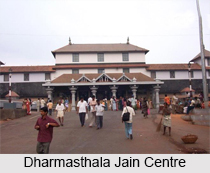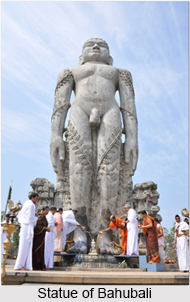 Dharmasthala is an Indian temple town on the banks of the Nethravathi River in the Belthangadi taluk of the Dakshina Kannada district in Karnataka, India. It is also a panchayat village, and it is the only village in its gram panchayat.
Dharmasthala is an Indian temple town on the banks of the Nethravathi River in the Belthangadi taluk of the Dakshina Kannada district in Karnataka, India. It is also a panchayat village, and it is the only village in its gram panchayat.
Location of Dharmasthala Jain Centre
Dharmastala is one of the sacred Jain centres in Karnataka. It is situated at 75 km east of Mangalore city and on the lower slopes of the Western Ghats. Dharmastala is a famous pilgrimage centre of Karnataka where hundreds of Indians visit daily to worship at its famous Manjunatha temple. This temple is quite modern and there is an interesting mixture of various faiths.
Administration of Dharmasthala Jain Centre
The temple is unusual in that it is run by a Jain administration and pujas are conducted by Hindu priests of Madhva order. Lakshadeepa, the festival of lights, is the annual festival of Dharmasthala in November–December. On an average the flow of pilgrims is about 10,000 people a day. A mechanised kitchen provides free food for all pilgrims and there are guest houses with modern amenities.
Dharmastala represents religious tolerance. A Jain Tirthankara is worshipped beside Daivas and Lord Manjunatha (Shiva). The priests are Vaishnavite Brahmins and the guardian of the temple a Heggade (Jain). To those who come here for justice, the Heggade dispenses judgements that are said to represent the will of the deities.
Hindus and Jains in Dharmasthala
 Dharmasthala is also a major pilgrimage centre for Hindus and Jains. The 39 feet Bahubali statue (175 tons) carved out of single rock by celebrated sculptor Ranjan Gopal Shenoy. The statue is consummate work of art and each of its lines and carves convey eternal values of a great religion and tradition. Dharmasthala represents religious tolerance.
Dharmasthala is also a major pilgrimage centre for Hindus and Jains. The 39 feet Bahubali statue (175 tons) carved out of single rock by celebrated sculptor Ranjan Gopal Shenoy. The statue is consummate work of art and each of its lines and carves convey eternal values of a great religion and tradition. Dharmasthala represents religious tolerance.
Legend of the Place Dharmasthala
Local legend says that the Shiva Linga in Dharmasthala was brought to Dharmasthala by a local person with great powers, named Annappa. Legend is that he used to work for the Heggade family. Once when the Heggade was serving he wanted to worship Lord Shiva, Annappa had assured him to get one linga and vanished from the sight. Next morning, he had already established the linga in Dharmasthala, a few metres away from Heggade`s house. Later it was known that the Linga was from Kadri near Mangalore, from the Kadri temple. By then, Annappa had vanished and he was never again sighted in the vicinity. Now people in Dharmasthala worship Annappa as Annappa Panjurli, a local god or deva and a hero.
800 Years ago, Dharmasthala was known as Kuduma in Mallarmadi, then a village in Belthangady. Here lived the Jain Chieftain Birmanna Pergade and his wife Ammu Ballathi in a house called Nelliadi Beedu. Pergade, the local chieftains built several shrines and invited Brahmin priests to perform the rituals. These priests requested Pergade to also install a Shivalinga beside the native Daivas. The Daivas then sent their vassal Annappa Swamy to procure the linga of Lord Manjunatheshwara from Kadri, near Mangalore. Subsequently, the Manjunatha temple was built around the linga.
Around the 16th century, Shri Devaraja Heggade invited Shri Vadiraja Swami of Udupi to visit the place. The Swamiji gladly came but refused to accept Bhiksha (food offering) because the idol of Lord Manjunatha had not been consecrated according to the vedic rites. Shri Heggade then requested the Swamiji to re-consecrate the shiva linga himself. Pleased by the observance of the vedic rites and Heggade`s charity to all, the Swamiji named the place Dharmasthala the abode of religion and charity. Thus, the roots of charity and religious tolerance established by the Pergades 800 years ago have been nurtured and strengthened by twenty one generations of the Heggade family, (Heggade being a derivative from Pergade). Today`s Dharmasthala blossoms with the fruit of this selfless dedication.





















